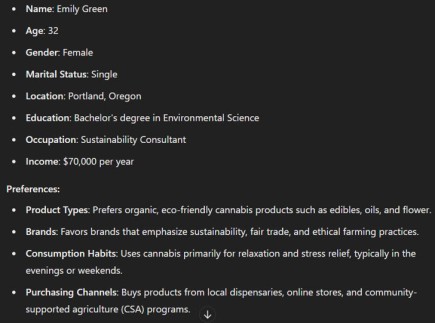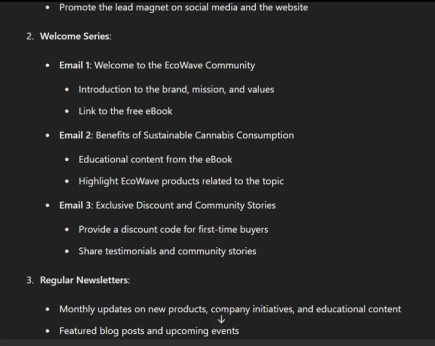Cannabis News
The Complete Guide to Building a Cannabis Brand with AI in 2024 and Beyond
Published
10 months agoon
By
admin

Practical Guide: Let’s build a Marijuana Brand using AI
Cannabis legalization is knocking on the door, and it’s just a matter of time before the powers that be realize they can’t keep this miracle plant under lock and key forever.
Sure, they might reschedule it, but mark my words, we’ll see full-blown descheduling in our lifetime. It might take a decade or two, but change is coming, and it’s coming fast.
Now, let’s talk about another game-changer: Artificial Intelligence. AI has been quietly infiltrating our lives, taking over the mundane tasks we used to slave over. It might not be perfect, but with a little human touch, AI can become one hell of an asset.
Just imagine the possibilities when we harness its power for our own benefit.
Sam Altman, the mastermind behind OpenAI, dropped a bombshell when he said the first solopreneur billionaire would be born from AI.
That’s a bold claim, but I believe it.
So, why not jump on this train and merge two of the hottest trends out there? Picture this: your very own cannabis brand, powered by the limitless potential of AI.
In this wild ride of an article, we’re going to walk you through the steps to make this dream a reality. We’ll dive into the nitty-gritty of building a brand from the ground up, all while leveraging the power of AI to give you a serious edge in the market.
So, buckle up, because we’re about to embark on a journey that could change your life. Are you ready to become the cannabis kingpin of the AI age?
Let’s find out.
Building a brand might seem like a daunting task, but let me tell you something: it’s easier than you think, especially when you’ve got AI on your side. With the right tools and a little bit of know-how, you can create a brand that stands out in the crowded cannabis market.
Here’s the deal, we’re going to break it down into nine fundamental steps:
-
Research Your Market and Audience
-
Define Your Brand Identity
-
Choose Your Brand Name and Logo
-
Create Your Brand’s Voice and Messaging
-
Design Visual Elements
-
Build Your Online Presence
-
Implement Your Brand Strategy
-
Promote Your Brand
-
Monitor and Adapt
We’re going to walk you through each of these steps, holding your hand the entire way. And here’s the best part: we’re going to build a faux brand together. That’s right, we’re going to create a brand from scratch, just to show you how it’s done. And if someone out there likes what they see and wants to run with it, be my guest. I won’t stand in your way.
So, are you ready to dive into the exciting world of cannabis brand building? I know I am. Let’s embark on this journey together and see where it takes us. Who knows, you might just end up with the next big thing in the cannabis industry. And if not, well, at least you’ll have a damn good time trying.
Alright, let’s talk about researching your market and audience. Now, I know what you’re thinking: “Research? That sounds like a lot of work.” But here’s the thing, with AI, it’s a breeze.
First up, you can use AI to gather data on your target market. We’re talking demographics, preferences, and buying habits. All the juicy details you need to create a brand that resonates with your audience.
But why stop there? You can even use AI to create a virtual stoner and interview them. That’s right, you can pick their brain and figure out what makes them tick. What are their pain points? What do they need? What do they desire? AI can help you get inside their head and understand what they value and how they communicate.
Now, I know you’re itching to get started, so here’s a SUPER PROMPT to help you out:
“Create a detailed persona of a typical cannabis user in [your target market]. Identify their demographics, preferences, pain points, needs, desires, values, and main forms of communication. Use this information to guide your brand’s research and development.”
Plug that into your favorite language model, and watch the magic happen. Trust me, with AI on your side, researching your market and audience has never been easier.

Now, let’s dive into brand identity.
This is where the rubber meets the road, and you get to define who you are as a brand. But before you start throwing around fancy words like “mission” and “vision,” you need to take a step back and understand what it is you’re actually selling.
Are you peddling products? Services? A little bit of both? Once you’ve got that figured out, you can start aligning your brand identity with your target market.
Now, let’s talk about your brand’s mission, vision, and core values. This is the stuff that’s going to set you apart from all the other cannabis brands out there. What do you stand for? What do you believe in? What makes you unique? These are the questions you need to answer if you want to create a brand that people can get behind.
But here’s the thing, you can’t just say you’re different. You need to prove it. That’s where your unique value proposition comes in. What sets you apart from the competition? Is it your superior product? Your commitment to sustainability? Your killer customer service? Whatever it is, make sure it’s something that your target market actually cares about.
Now, I know you’re probably thinking, “This sounds like a lot of work.” But don’t worry, I’ve got you covered. Here’s a SUPER PROMPT to help you get started:
“Create a brand identity for a cannabis company targeting [your target market]. Define the company’s mission, vision, and core values, and identify its unique value proposition. Ensure that the brand identity aligns with the target market’s needs, desires, and values.”
Plug that into your favorite AI tool, and watch as your brand identity takes shape. Remember, your brand identity is the foundation of everything you do, so take the time to get it right.

Alright, so you’ve got your brand identity all figured out. Now it’s time to put a name and a face to it. And by face, I mean logo. But don’t worry, you don’t need to be some kind of creative genius to come up with a killer brand name and logo. That’s what AI is for.
First up, let’s talk about your brand name. You want something that’s memorable, easy to pronounce, and reflects your brand identity. But coming up with a name can be tough. That’s where AI comes in. You can use tools like namelix.com or Jasper.ai to generate hundreds of potential names based on your brand keywords and preferences. And the best part? You don’t have to sift through all the terrible ones yourself. AI will do that for you.
But a name is just the beginning. You also need a color palette that reflects your brand’s personality and values. Again, AI has got you covered. Tools like Khroma.co and Coolors.co can generate color palettes based on your brand keywords and preferences. And if you’re feeling extra lazy, you can even use AI to suggest a logo based on your brand name and color palette.
But hold up, I know what you’re thinking. “How do I come up with a prompt for an image generator?” Don’t worry, that’s where language models like ChatGPT come in. You can use them to generate prompts based on your brand identity and preferences. Something like: “Generate a logo for a cannabis brand called [your brand name] using the colors [your color palette]. The logo should reflect the brand’s [your brand values] and appeal to [your target market].”
And just like that, you’ve got a complete brand identity, courtesy of AI. But don’t just take my word for it. Here’s a SUPER PROMPT to help you achieve all of this in one go:
“Create a complete brand identity for a cannabis company targeting [your target market]. Generate a brand name, color palette, and logo that reflects the brand’s mission, vision, and core values. Provide the final results in a single, cohesive brand identity document.”
Plug that into your favorite AI tool, and watch as your brand comes to life.


Alright, let’s talk about your brand’s voice and messaging. This is where you get to let your personality shine through and really connect with your audience. But what if you’re not sure what your brand’s personality is? Or how to communicate with your target market? Don’t worry, AI has got your back.
First things first, you need to establish your brand’s voice. Are you funny and irreverent? Serious and educational? Somewhere in between? AI can help you figure that out. Tools like IBM Watson Tone Analyzer and Adeptmind.ai can analyze your existing content and give you insights into your brand’s personality and tone. From there, you can use language models like GPT-3 to generate content that matches your brand’s voice.
But here’s the thing, you can’t just assume that your brand’s voice is resonating with your audience. That’s where A/B testing comes in. You can use AI to generate multiple versions of your messaging and test them out on your target market. See what works and what doesn’t, and refine your messaging accordingly.
And speaking of messaging, you need to make sure that your key messages are conveying your brand’s values and benefits. What do you want your audience to know about your brand? What makes you different from the competition? AI can help you craft messaging that speaks directly to your target market’s pain points and desires.
But perhaps most importantly, you need to have a clear set of business mantras that guide everything you do. What are the non-negotiables for your brand? What do you stand for? AI can help you distill your brand identity into a set of clear, concise mantras that you can use to guide your decision-making and communication.
So, ready to get started? Here’s a SUPER PROMPT to help you create your brand’s voice and messaging:
“Create a comprehensive brand voice and messaging guide for a cannabis company targeting [your target market]. Use AI tools to analyze the brand’s existing content and generate new content that matches the brand’s personality and tone. Craft key messages that convey the brand’s values and benefits, and distill the brand identity into a set of clear business mantras. Provide the final results in a single, cohesive document.”
Plug that into your favorite AI tool, and watch as your brand’s voice and messaging takes shape. And remember, your brand’s voice is what sets you apart from the competition. So make it count.

Alright, let’s talk about the fun part: designing your brand’s visual elements. This is where you get to let your creativity run wild and really bring your brand to life. But if you’re not a designer, don’t worry. AI has got you covered.
First up, you need to establish your brand’s color palette, typography, and design guidelines. This is the foundation of all your visual elements, so it’s important to get it right. You can use tools like Khroma.co and Fontjoy.com to generate color palettes and font pairings that match your brand’s personality and values. And if you’re not sure where to start, you can use AI-powered design tools like Canva and Crello to generate templates and guidelines for you.
But your visual elements don’t stop there. You also need to create things like business cards, packaging, and website design. Again, AI can help with that. Tools like Magicpattern.design and Patternpad.com can generate custom patterns and textures for your packaging and website. And if you need mockups, you can use AI-powered tools like Smartmockups.com and Mockupworld.co to generate them for you.
Once you’ve got your mockups, it’s time to bring them to life. If you’re using Figma, you can use AI-powered plugins like Autoflow and Automator to replicate your wireframes and designs. And if you’re building a website, you can use AI-powered builders like Elementor and Wix to create stunning designs with just a few clicks.
But perhaps most importantly, you need to make sure that your visual elements are consistent across all your channels. Whether it’s your website, your social media, or your packaging, your brand should be instantly recognizable. That’s where AI-powered brand management tools like Lucidpress and Bynder come in. They can help you create and manage your brand assets across all your channels, ensuring that your brand is always on point.
So, ready to get started? Here’s a SUPER PROMPT to help you create your brand’s visual elements:
“Create a comprehensive visual identity guide for a cannabis company targeting [your target market]. Use AI tools to generate color palettes, typography, and design guidelines that match the brand’s personality and values. Create mockups for business cards, packaging, and website design using AI-powered tools. Provide the final results in a single, cohesive document.”
Plug that into your favorite AI tool, and watch as your brand’s visual identity comes to life. And remember, your brand’s visual identity is what makes you stand out from the crowd. So make it count.

Alright, let’s talk about building your online presence. This is where you get to connect with your audience and really showcase what your brand is all about. But with so many channels and platforms out there, it can be overwhelming to know where to start. That’s where AI comes in.
First up, you need to create content that resonates with your audience. And I’m not talking about fluffy, generic content that doesn’t say anything. I’m talking about content that speaks directly to your customers’ pain points and needs. You can use AI-powered tools like Jasper.ai and Content Villain to generate articles, social media posts, and other types of content that are tailored to your target market. These tools can analyze your audience’s interests and behavior and create content that’s more likely to engage and convert them.
But creating content is just the first step. You also need to make sure that your content is being seen by the right people at the right time. That’s where social media planners like SocialChamp come in. These tools can help you schedule and automate your content across all your social media channels, ensuring that your brand is always top of mind for your audience.
But here’s the thing: you can’t just set it and forget it. You need to be constantly reviewing your metrics and adapting your strategy accordingly. Use AI-powered analytics tools like Sprout Social and Hootsuite to see when your customers are engaging with your content, where they’re hanging out online, and what kind of content they’re responding to. Then, use that information to refine your strategy and create even more targeted content.
And don’t forget about ads. I know, I know, ads can be annoying. But if you can create a positive revenue stream using ads, your organic systems will work even better. You can use AI-powered ad tools like Adext AI and Albert.ai to create and optimize your ad campaigns, ensuring that you’re getting the best possible ROI.
But perhaps most importantly, you need to build a funnel. Create a lead magnet, like an ebook or a free trial, and use it to collect emails and other contact information from your audience. Then, use AI-powered email marketing tools like Mailchimp and Constant Contact to nurture those leads and turn them into loyal customers.
So, ready to get started? Here’s a SUPER PROMPT to help you build your online presence:
“Create a comprehensive online presence strategy for a cannabis company targeting [your target market]. Build a funnel by creating a lead magnet and collecting emails using AI-powered email marketing tools. Provide the final results in a single, cohesive document.”
Plug that into your favorite AI tool, and watch as your online presence takes off. And remember, your online presence is what connects you with your audience. So make it count.

Alright, let’s wrap this up with the final three steps. You’ve done the hard work of creating your brand identity, designing your visual elements, and building your online presence. Now it’s time to put it all into action.
First up, you need to implement your brand strategy. This means making sure that every touchpoint with your customers, from your website to your packaging to your customer service, is consistent with your brand identity. You can use AI-powered tools like Lucidpress and Bynder to create and manage your brand assets, ensuring that everyone in your organization is on the same page.
But creating a great brand is only half the battle. You also need to promote it. And that’s where ads come in. You can use AI-powered ad tools like Adext AI and Albert.ai to create and optimize your ad campaigns, ensuring that you’re reaching the right people with the right message at the right time. But don’t just set it and forget it. Use AI-powered analytics tools to monitor your ad performance and adapt your strategy accordingly.
And finally, you need to monitor and adapt. Your brand is a living, breathing thing, and it needs to evolve with your customers’ needs and preferences. Use AI-powered analytics tools to track your brand’s performance across all channels, from your website to your social media to your ads. And don’t be afraid to make changes based on what you learn. Your brand should always be growing and improving.
Now, I know what you’re thinking. “But wait, these steps don’t necessarily require AI!” And you’re right. But here’s the thing: AI can make all of these steps easier and more effective. You can use AI to run your campaigns by a persona, test your content, and refine your work. It’s like having a personal assistant that never gets tired and never takes a day off.
So no excuses. Get to work, create something beautiful!
ARTIFICIAL INTELLIGENCE IN THE WEED INDUSTRY, READ ON..
You may like
-


The Best Tariff Friendly Cocktails
-


Cannabis Consumers Are Being Hit By The Tariffs
-


The Best Tips To Update Your Wardrobe
-


Former New York Knick Iman Shumpert debuts ‘TSA Approved’ legal cannabis brand
-


How New York pot pioneers made it to legal dispensary shelves
-


Scientists Now Think That One Compound in the Cannabis Plant Can Replace All Opiates
Cannabis News
Scientists Now Think That One Compound in the Cannabis Plant Can Replace All Opiates
Published
16 hours agoon
April 3, 2025By
admin

Which Cannabis Compound Do Scientists Think Can Replace Opiates?
…And Why This Is Important
Opiates are a type of pharmaceutical drug that’s been made from the opium poppy plant. While it’s somewhat a ‘natural’ substance that’s been extracted from the fibers and sap of the opium poppy plant, these are extremely dangerous sedatives that act on the central nervous system. However, there are completely synthetic opioids as well, which are manufactured entirely in laboratories.
Famous examples of well-known and widely-used opiates today include heroin, codeine, and morphine. They all work similarly, binding to the brain’s opioid receptors and users feel a drastic reduction in pain. It also causes users to feel euphoric, drowsy, or sleepy. Common side effects include constipation and nausea.
Because opiates are powerful for dulling one’s pain perceptions, they have become commonly prescribed by doctors and hospitals for pain relief. That said, opiates have become one of the world’s most addictive, dangerous, and fatal drugs – and you can get prescribed it right by your very own physician. Repeated use of opiates can easily lead to dependence and addiction, and eventually consuming high doses can drastically slow down breathing, and cause brain damage, or even death.
Since doctors still keep prescribing opioids, this has resulted in the deadly Opioid Epidemic, which has killed thousands of people. It’s a worrisome public health crisis, most especially because of fentanyl, an illegally manufactured opioid which is said to be 50 times more potent than heroin.
Could The Answer To The Opioid Epidemic Lie In Cannabis…Terpenes?
The past few years have shown that cannabis legalization is critical for surviving the opioid epidemic, and reducing overall opioid consumption.
The results of a recent research paper, which builds on past studies conducted by Dr. John Streicher, who is a member of the Comprehensive Center for Pain and Addiction, reveals fascinating findings. According to Streicher, cannabis terpenes were found to provide relief in inflammation models as well as on neuropathic pain caused by chemotherapy.
For the study, Streicher and his research team analyzed 4 kinds of terpenes that are found in mid to high levels in Cannabis sativa plants: linalool, geraniol, beta-caryophyllene, and alpha-humulene. They discovered that each terpene produced significant pain relief among mice subjects with fibromyalgia and post-operative pain, and among the terpenes, geraniol was found to be the most powerful.
“Our research is showing that terpenes are not a good option for reducing acute pain resulting from an injury, such as stubbing your toe or touching a hot stove; however, we are seeing significant reductions in pain when terpenes are used for chronic or pathological pain,” he said. “This study was the first to investigate the impact of terpenes in preclinical models of fibromyalgia and post-operative pain and expand the scope of potential pain-relieving treatments using terpenes,” Streicher said.
Cannabis terpenes are the compounds responsible for the aromatic profile of each strain; they are located in the plant trichomes. Not only do they contribute to each strain’s unique flavor and odor, but they also have valuable therapeutic and medicinal benefits. There are around 150 kinds of terpenes known today, though in the entire plant world, there are known to be some 20,000 terpenes.
Understanding the therapeutic benefits of terpenes is incredibly valuable also because they don’t contain THC (tetrahydrocannabinol), the compound in marijuana that gets you high.
“With fibromyalgia, there isn’t much of an understanding of what the pain state is, and there are not a lot of great options for treating it,” explains Streicher. “Our findings show that terpenes may be a viable treatment option for fibromyalgia pain, which could potentially have a large impact and make a difference for an under-treated population.”
Other Studies
This is not the first time that cannabis terpenes have been found to demonstrate excellent pain-relieving properties. It must be noted that just like what Streicher says, terpenes seem to do better with chronic pain management, instead of acute pain management.
Another study from 2024, which was published in The Journal of the Association for the Study of Pain, was conducted by researchers at the University of Arizona and the National Institutes of Health. The investigators analyzed the analgesic properties of different terpenes including geraniol, humulene, linalool, pinene, and caryophyllene among mice subjects with chemotherapy-induced peripheral neuropathy.
According to the researchers, all the terpenes delivered analgesic effects that were equivalent to around 10 mg/kg of morphine. It was also interesting to note that administering both morphine and terpenes together at low doses resulted in ‘enhanced’ pain-killing effects.
“Together these studies identify cannabis terpenes as potential therapeutics for chronic neuropathic pain,” said the investigators.
There have also been other studies that have found that combining cannabis with opioids can indeed provide long-lasting pain relief. It comes with the added benefit of reducing opioid doses needed for effective pain control. This phenomenon is called opioid-sparing. These types of protocols can be beneficial for patients who suffer from severe, chronic pain caused by cancer, arthritis, joint problems, fibromyalgia, diabetes, post-surgical pain, migraines, nerve damage, and so much more.
Conclusion
Learning more about the pain-killing properties of terpenes is extremely valuable for the medical community, patients, and even society as a whole. We can all do with less opioid addictions because it has torn families apart, and caused the deaths of thousands of people.
Terpenes, or cannabis in general, offer a natural and safe alternative that can be complementary to other pharmaceutical treatments designed to reduce pain.
SWAPPNG OPIOIDS FOR CANNABIS, READ ON…


Cannabis and the Authoritarian State
Cannabis has been legal for longer than it has been illegal. Let that sink in for a minute. For thousands of years, humans cultivated and consumed cannabis freely across civilizations and continents. It wasn’t until the early 1900s that we witnessed a massive push to drive hemp and cannabis into the black market, primarily due to industrial competition from petrochemicals, pharmaceuticals, and other industrial applications.
What makes cannabis so threatening to powerful interests? For starters, hemp and cannabis are highly versatile crops with over 50,000 different uses, from medicine to textiles to fuel. Even more remarkable is how this plant is hardwired to work with the human body through our endocannabinoid system—a biological network we didn’t even discover until the 1990s.
Perhaps most threatening of all is that cannabis is insanely easy to grow. This means that if the plant helps you with a particular physical ailment, you have the ability to grow your own medicine indefinitely. No insurance premiums, no wait lists, no pharmaceutical middlemen—just you cultivating your own healing directly from the earth.
Authoritarians do not like this, not one bit. When people can meet their own needs independently, power structures lose their grip. When citizens can think differently without permission, control systems begin to fail. So today, we’re going to look at the interesting relationship between authoritarianism and cannabis, and how this humble plant plays a key role in keeping you free.
We’ve already established the versatility of cannabis, but there’s another element that those old D.A.R.E. PSAs inadvertently reveal about what authoritarians think about cannabis. I’m talking, of course, about “behavior.” You see, in an authoritarian system, you and I are but cogs in the machine. We’re the expendables who should be proud to work ourselves to death for our “fearless leaders.”
This is precisely why certain ideas, philosophies, religions, movements, books, and substances are typically banned in authoritarian regimes. Take North Korea as an example: everything from the type of television citizens watch to the music they hear is a tightly spun spell designed to keep the populace in check. While they don’t have explicit laws against hemp (they actually grow it industrially), smoking psychoactive cannabis is strictly forbidden.
Contrast this with places like Malaysia, where you can get up to 5 years for possessing just 20 grams of cannabis, and even face the death penalty depending on the situation. These authoritarians don’t play around when it comes to cannabis because they know it affects the behavior of their populace in ways they can’t control.
The question becomes: what behavior do they fear so much that cannabis produces within the individual?
The answer is a critical mind. People who consume cannabis often begin to question their own belief systems. Most regular users undergo some transformation in their values and perspectives. Cannabis has a unique way of helping people see beyond cultural programming and think outside established paradigms. It can make the familiar strange and the strange familiar—a psychological state that’s antithetical to authoritarian control.
This independent thinking runs counter to the narrative of authoritarians who wish to maintain a tight grip on social consciousness. If even 10% of a population begins to pivot in their behavior within a regime, it can have massive ripple effects. Just look at cannabis in the US—it went from being demonized to being embraced by the majority in less than 80 years, despite massive propaganda efforts.
For authoritarians, psychoactive cannabis isn’t primarily a threat to public health and wellbeing—it’s a threat to the health and wellbeing of authoritarianism itself. When people start thinking differently, they start living differently. When they start living differently, they start demanding different. And that’s the beginning of the end for any system built on unquestioning obedience.
Beyond the threat to thought control, there’s another reason why drugs in general remain illegal: the state can use prohibition as a weapon against the populace. This isn’t conspiracy theory—it’s documented history.
Take Nixon’s war on drugs. His domestic policy chief, John Ehrlichman, later admitted: “We knew we couldn’t make it illegal to be either against the war or black, but by getting the public to associate the hippies with marijuana and blacks with heroin, and then criminalizing both heavily, we could disrupt those communities.” Nixon essentially placed cannabis on the Controlled Substances Act because he needed an excuse to shut down anti-war protests and target Black communities.
Since hippies and anti-war protesters were smoking “freedom grass,” making it illegal would circumvent their freedom of speech and freedom of assembly, and more importantly—turn free citizens into state property. It’s a win-win if you’re an authoritarian looking to silence dissent.
Then there’s the whole “boogeyman” complex that prohibition creates. We’re told “drug dealers” are roaming the streets preying on innocents, giving them “marihuanas” so they can do vile things. What the government conveniently leaves out is how the banks these “dealers” use to launder their money remain untouched. They don’t mention the shadier dealings of law enforcement either—like running guns into Mexico (eventually leading to the death of one of their own), or spraying poison on crops, killing and hospitalizing people because, you know…”Drugs are bad!”
Authoritarians cannot let go of the value that keeping the most widely used illicit substance in the world illegal provides them. This explains why the US hasn’t federally legalized cannabis despite nearly 80% of Americans supporting some form of legalization. It’s not because they don’t have enough research or that they’re genuinely concerned about public health—it’s because prohibition gives them all the privileges of violating constitutional rights while siphoning money into their coffers.
Drug prohibition creates a perpetual enemy that can never be defeated, allowing endless justification for surveillance, militarized police, asset forfeiture, and expansion of state power. What authoritarian could resist such a convenient tool?
Cannabis is a plant. You can’t make nature illegal—it’s counter to the human experience. When governments attempt to criminalize a naturally occurring organism that humans have cultivated and used for thousands of years, they reveal the absurdity of their position and the limits of their authority.
While the United States isn’t a full-on authoritarian state (yet), the truth is that many authoritarian elements have played out over the years. You only need to look as far as the war on drugs to see how the state utilizes prohibition as a weapon to their advantage. From no-knock raids to civil asset forfeiture to mass incarceration, drug laws have erected a parallel legal system where constitutional protections often don’t apply.
The fundamental truth is that cannabis is not only versatile and medicinal, it gives you back your autonomy in multiple ways. It helps you think for yourself. It allows you to grow your own medicine. It connects you with a plant that humans have used ceremonially, medicinally, and industrially throughout our history. And this autonomy is something authoritarians cannot stand—free individuals who know how to think beyond the narratives they’re fed.
Cannabis doesn’t just get you high—it offers a perspective from which the absurdities of prohibition become glaringly obvious. Perhaps this is why, as state after state legalizes, we’re witnessing the slow but steady unraveling of one of the most enduring authoritarian policies in American history.
So if you count yourself among those who value freedom of thought and bodily autonomy, who believe that nature doesn’t require government permission, and who understand that true liberty includes the right to explore your own consciousness—well, maybe it’s time to toke one up for freedom!
LEGALIZING CANNABIS IS NOT ENOUGH, READ ON..
Cannabis News
Stop Using Bat Poop to Fertilize Your Weed Plants Immediately, Here is Why…
Published
3 days agoon
April 1, 2025By
admin

Don’t Fertilize Your Weed with Bat Poop
Fertilization is a critical step for growing healthy marijuana plants.
They help provide essential nutrients for marijuana in various stages of growth, while promoting plant growth. There are dozens of different fertilizers to choose from in the market; growers can choose based on budget, nutrients needed, location, season, and much more. But not all fertilizers are made equally – of course, some are of better quality than others.
That said, there are some rather unusual fertilizers that can be used on plants. These may include, but are not limited to: coffee, milk, grass clippings, banana peels, fish tank water, potato water, and even urine! Yes, it does sound strange, but to gardening enthusiasts, there is nutritional value to be found in each of these things, which can make them suitable fertilizers depending on the circumstances.
For example, grass clippings make excellent mulch and can provide potassium, nitrogen, and phosphorus. Urine is a potent source of nitrogen as well as phosphorus. Banana peels are rich in calcium, which is excellent for promoting root growth while helping supply oxygen to the soil.
But what about bat poop? Also known as guano, bat poop has been said to work as a plant fertilizer because it’s rich in nitrogen, potassium, phosphorus, and other nutrients. Unfortunately, using bat poop as a plant fertilizer can also be dangerous. So if you don’t really know what you are doing, bat poop as a fertilizer can be extremely risky.
Bat Poop Fertilizer Kills 2 NY Men
On December 2024, news of two men hailing from Rochester, New York, dying went viral.
The cause of death was dangerous fungus, in the bat poop that they were using to fertilize their marijuana plants. Both men grew their own marijuana plants for medical consumption, but unfortunately developed histoplasmosis after breathing toxic fungal spores from the guano.
One of the men was aged 59 years old; he bought bat poop online to use as fertilizer for his plants. Meanwhile, the other was a 64-year-old male who found guano in his attic, then decided to use it to fertilize his cannabis plants. They both developed similar symptoms, including chronic coughs, fever, severe weight loss, and respiratory failure. The case was also discussed in the Open Forum Infectious Diseases medical journal.
Is there a safe way to use bat poop as fertilizer? If you ask me, I truly can’t understand why one would use guano as fertilizer when there are so many other proven safe alternatives out there that are simply not as risky. According to the University of Washington, one must always wear a dust mask each time you open a bag containing soil amendments. That’s because a mask will greatly decrease the chances of breathing in fungal spores, which could be potentially dangerous. They also go on to explain that yes, guano is indeed used as fertilizer for its valuable nitrogen content but it still isn’t without its own risks, particularly of developing Histoplasma – the same condition that killed the two men.
Make Your Own Safe Fertilizers At Home
There are many other safe, affordable – and even free – fertilizers you can feed your marijuana plants with. It doesn’t have to cost a fortune nor does it have to be risky to your health.
Check out these easy, low-cost, DIY fertilizers for weed:
-
Coffee grounds are abundant in nitrogen, which makes it perfect for the vegetative stage of marijuana plants. They are also a fantastic source of organic materials and green waste, which contain other vital nutrients. When the coffee grounds decompose, they create soil aggregates that improve soil aeration and its water retention capabilities.
Mix around 2 grams of coffee ground for every liter of soil. Measuring its pH levels is also helpful, since you want it to be between 6 to 6.5
-
Crushed eggshells are a great way to ensure no eggshells go to waste. It’s rich in calcium plus other minerals that are effective in improving overall plant structure, health, and growth. In fact, so many gardeners and farmers commonly use crushed eggshells to help boost plant growth – and it will work just as well for marijuana plants.
They’re really easy to use, too! Just mix eggshells into the soil, or steep them into water then pour into the soil for a calcium-packed feed.
-
Banana tea or water is rich in potassium and magnesium, making it perfect as a feed during the marijuana plant’s flowering stage. You can use banana peels differently: with 3 to 5 banana peels, soak it in water for 2 days. Then you can use the water on your plants, and even leave the banana peels as compost for your garden.
-
Wood ash from your fireplace or other sources is a great source of phosphorus and potassium. Simply sprinkle some wood ash over marijuana during the final flower phase. Just use 1 or 2 grams of ash for every liter of substrate. Be careful not to use too much wood ash, or it can make the soil too alkaline.
-
Animal manure, such as those from cows, rabbits, or horses, make excellent organic fertilizers. Just be sure that they’re composed properly so that you avoid introducing weed seeds, or pathogens.
These low-cost fertilizers are also natural and effective. There’s no reason for you to turn to bat poop as fertilizer, even if you’re in a bind.
Conclusion
Guano or bat poop is a poor choice of fertilizer if you don’t know what you are doing. It’s risky and potentially dangerous – just not worth it. Instead, fertilize your marijuana plants with these options mentioned.
BEST POOP FOR CANNABIS PLANTS, KEEP READING…

The Best Tariff Friendly Cocktails

Cannabis Consumers Are Being Hit By The Tariffs

The Best Tips To Update Your Wardrobe

Former New York Knick Iman Shumpert debuts ‘TSA Approved’ legal cannabis brand

How New York pot pioneers made it to legal dispensary shelves

Scientists Now Think That One Compound in the Cannabis Plant Can Replace All Opiates

Vladimir Bautista is leading Happy Munkey’s legacy-to-legal takeover

Cannabis Can Help A Sore Throat

Cannabis and the Authoritarian State

As cannabis consumer tastes evolve, industry must look beyond potency

Distressed Cannabis Business Takeaways – Canna Law Blog™

United States: Alex Malyshev And Melinda Fellner Discuss The Intersection Of Tax And Cannabis In New Video Series – Part VI: Licensing (Video)

What you Need to Know

Drug Testing for Marijuana – The Joint Blog

NCIA Write About Their Equity Scholarship Program

It has been a wild news week – here’s how CBD and weed can help you relax

Cannabis, alcohol firm SNDL loses CA$372.4 million in 2022

A new April 20 cannabis contest includes a $40,000 purse

Your Go-To Source for Cannabis Logos and Designs

UArizona launches online cannabis compliance online course
Trending
-

 Cannabis News2 years ago
Cannabis News2 years agoDistressed Cannabis Business Takeaways – Canna Law Blog™
-

 One-Hit Wonders2 years ago
One-Hit Wonders2 years agoUnited States: Alex Malyshev And Melinda Fellner Discuss The Intersection Of Tax And Cannabis In New Video Series – Part VI: Licensing (Video)
-

 Cannabis 1012 years ago
Cannabis 1012 years agoWhat you Need to Know
-

 drug testing1 year ago
drug testing1 year agoDrug Testing for Marijuana – The Joint Blog
-

 Education2 years ago
Education2 years agoNCIA Write About Their Equity Scholarship Program
-

 Cannabis2 years ago
Cannabis2 years agoIt has been a wild news week – here’s how CBD and weed can help you relax
-

 Marijuana Business Daily2 years ago
Marijuana Business Daily2 years agoCannabis, alcohol firm SNDL loses CA$372.4 million in 2022
-

 California2 years ago
California2 years agoA new April 20 cannabis contest includes a $40,000 purse







